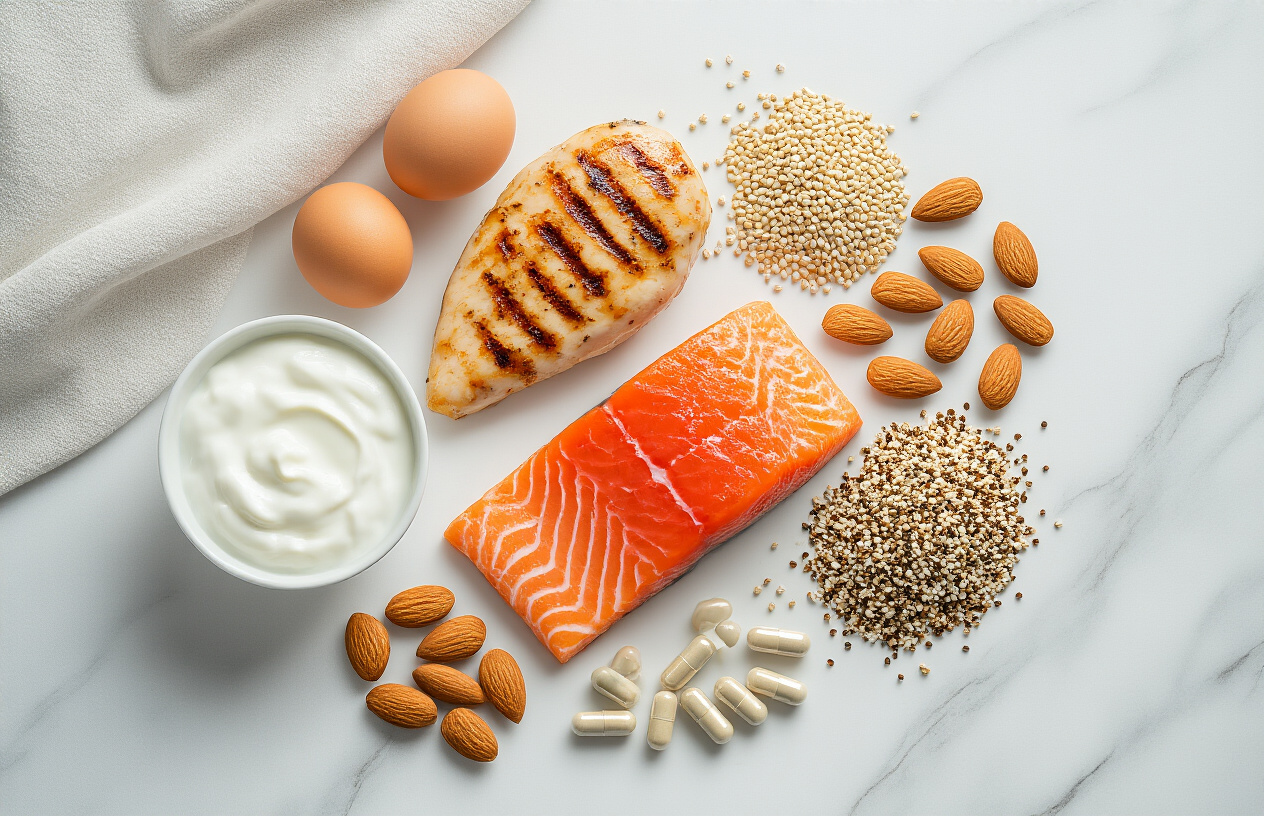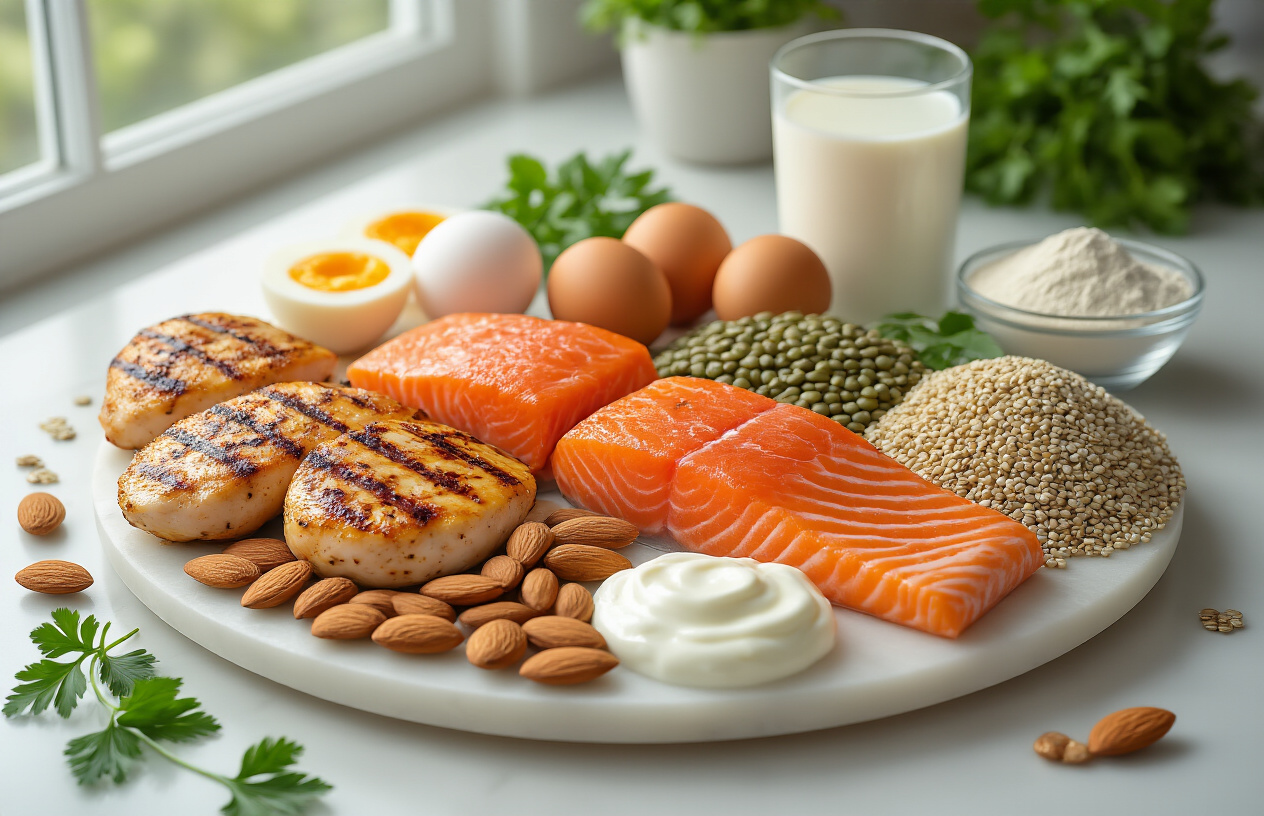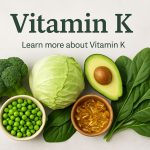How much protein do you really need? The answer isn’t as simple as the number on a supplement bottle or generic fitness advice.
This guide is for anyone who wants to cut through the confusion about protein requirements – from busy professionals trying to stay healthy to fitness enthusiasts optimizing their performance.
You’ll learn how to calculate your personal protein needs based on your body and goals, not cookie-cutter recommendations. We’ll explore the best protein sources that actually deliver results and help you avoid the common mistakes that waste money and limit your progress.
Stop guessing about your protein intake and start making informed decisions that work for your lifestyle.
Understanding Your Body’s Protein Requirements

Calculate Your Personal Daily Protein Needs
Your protein needs aren’t one-size-fits-all. The baseline recommendation of 0.8 grams per kilogram of body weight works for sedentary adults, but most people need more. If you weigh 70 kilograms (154 pounds), that’s about 56 grams daily – roughly what you’d get from a chicken breast and a cup of Greek yogurt.
Active individuals require significantly more protein. Endurance athletes should aim for 1.2-1.4 grams per kilogram, while strength trainers need 1.6-2.2 grams per kilogram. Someone weighing 80 kilograms who lifts weights regularly would need 128-176 grams of protein daily.
Quick calculation method:
- Sedentary: Body weight (kg) × 0.8
- Moderately active: Body weight (kg) × 1.2-1.4
- Very active/strength training: Body weight (kg) × 1.6-2.2
Weight loss changes the equation too. Higher protein intake (1.2-1.6 grams per kilogram) helps preserve muscle mass during caloric restriction and increases satiety.
Recognize How Age Affects Your Protein Demands
Protein needs shift dramatically as you age. Children and teenagers require more protein per kilogram than adults because they’re building new tissue. A 14-year-old needs about 0.85 grams per kilogram compared to an adult’s 0.8 grams.
After 50, your body becomes less efficient at using protein. Sarcopenia – age-related muscle loss – accelerates without adequate protein intake. Older adults should consume 1.0-1.2 grams per kilogram, with some research suggesting even higher amounts benefit muscle preservation.
Age-based protein recommendations:
| Age Group | Protein (g/kg body weight) |
|---|---|
| Children 4-8 | 0.95 |
| Teens 14-18 | 0.85 |
| Adults 19-50 | 0.8 |
| Adults 50+ | 1.0-1.2 |
Digestive changes with aging mean older adults benefit from spreading protein throughout the day rather than consuming large amounts in single meals. Aim for 25-30 grams per meal to maximize muscle protein synthesis.
Identify Gender-Specific Protein Differences
Men typically need more total protein than women due to higher muscle mass and body weight. A 180-pound man requires about 65 grams daily for basic needs, while a 130-pound woman needs around 47 grams.
Women face unique protein challenges during different life stages. Pregnancy increases protein needs to 1.1 grams per kilogram, while breastfeeding bumps it to 1.3 grams per kilogram. A 60-kilogram pregnant woman needs about 66 grams daily – that’s 18 grams more than her pre-pregnancy requirement.
Menstrual cycles affect protein metabolism too. The luteal phase (post-ovulation) increases protein breakdown, making adequate intake more important during this time. Female athletes often need the same relative protein intake as male counterparts when matched for training intensity and goals.
Key gender considerations:
- Men: Higher absolute needs due to body size
- Women: Fluctuating needs based on hormonal cycles
- Pregnancy: Additional 25 grams daily
- Breastfeeding: Additional 25 grams daily beyond pregnancy needs
Both genders benefit from leucine-rich proteins, but women may need slightly more leucine to trigger the same muscle protein synthesis response as men.
Optimize Protein Intake for Your Lifestyle Goals

Boost Muscle Growth with Strategic Protein Timing
Muscle growth isn’t just about eating protein—timing matters significantly. Your muscles respond best when they receive steady protein signals throughout the day. The concept of the “anabolic window” suggests consuming 20-25 grams of high-quality protein within 30-60 minutes after resistance training maximizes muscle protein synthesis.
Research shows spreading protein intake across meals works better than loading up on massive amounts at once. Aim for 25-30 grams per meal, roughly every 3-4 hours. This approach keeps your body in a constant muscle-building state rather than experiencing protein feast-or-famine cycles.
Pre-workout protein can also enhance muscle building. Having 15-20 grams about 30 minutes before training provides amino acids when your muscles need them most. Evening protein, particularly casein or slow-digesting sources, supports overnight muscle repair and growth.
Accelerate Weight Loss Through Protein Management
Protein becomes your secret weapon for sustainable weight loss. It has the highest thermic effect of all macronutrients, meaning your body burns more calories just digesting and processing it compared to carbs or fats. This metabolic boost can increase daily calorie burn by 80-100 calories.
Higher protein intake dramatically improves satiety. People eating 25-30% of calories from protein report feeling fuller longer and naturally reduce overall food intake without conscious restriction. This makes maintaining a calorie deficit much easier.
Protein preserves lean muscle mass during weight loss. Without adequate intake, up to 25% of weight lost comes from muscle rather than fat. This slows metabolism and creates the dreaded skinny-fat appearance. Consuming 1.2-1.6 grams per kilogram of body weight while in a calorie deficit maintains muscle mass.
Start each meal with protein to control hunger and prevent overeating later. This strategy helps regulate hormones like ghrelin and leptin that control appetite and satiety signals.
Enhance Athletic Performance with Targeted Intake
Athletic performance demands depend heavily on your sport and training intensity. Endurance athletes need 1.2-1.4 grams per kilogram of body weight to support prolonged training sessions and recovery. Strength and power athletes require 1.6-2.2 grams per kilogram to fuel muscle repair and adaptation.
Team sport athletes fall somewhere between these ranges, typically needing 1.4-1.7 grams per kilogram. The intermittent high-intensity nature of sports like basketball, soccer, and hockey creates unique protein demands.
Training phase matters too. During heavy training blocks or competition seasons, protein needs increase by 10-20%. Recovery periods may allow for the lower end of recommendations. Competition day nutrition should include familiar protein sources 2-3 hours before events to support sustained energy and muscle function.
Leucine, an amino acid found in whey protein, plays a crucial role in triggering muscle protein synthesis. Athletes benefit from consuming 2.5-3 grams of leucine per meal, easily achieved through 25-30 grams of complete protein.
Support Recovery and Healing with Adequate Amounts
Recovery extends beyond just muscle repair. Protein supports immune function, hormone production, and tissue healing throughout your body. During periods of increased stress, illness, or intense training, protein requirements can jump by 25-50%.
Sleep quality improves with proper protein timing. Consuming 20-30 grams of casein protein before bed provides a steady stream of amino acids during overnight recovery. This supports growth hormone release and muscle repair while you sleep.
Injury recovery demands special attention to protein intake. Healing tissues require additional amino acids for collagen synthesis and cellular repair. Injured athletes should increase intake to 2.0-2.5 grams per kilogram of body weight and include vitamin C-rich foods to support collagen formation.
Age affects protein needs for recovery. Adults over 40 experience reduced muscle protein synthesis efficiency, requiring higher per-meal amounts (30-35 grams) to achieve the same recovery benefits as younger individuals. This becomes increasingly important for maintaining muscle mass and recovery capacity as we age.
Discover High-Quality Protein Sources for Maximum Benefits

Choose Complete vs Incomplete Proteins Wisely
Complete proteins contain all nine essential amino acids your body can’t produce on its own. Think of them as the full toolkit your muscles need for repair and growth. Animal sources like chicken, fish, eggs, and dairy naturally provide complete proteins, making them straightforward choices for meeting your amino acid needs.
Incomplete proteins miss one or more essential amino acids, but don’t write them off. Beans, nuts, seeds, and grains fall into this category, yet they’re incredibly valuable when paired strategically. Rice and beans create a complete amino acid profile when eaten together – your body doesn’t even need them in the same meal, just within the same day.
Quinoa and soy stand out as plant-based complete proteins, offering vegetarians and vegans convenient single-source options. Hemp seeds, chia seeds, and spirulina also pack complete amino acid profiles while delivering additional nutrients like healthy fats and minerals.
The key lies in variety rather than perfection. Your body pools amino acids throughout the day, so combining different protein sources naturally covers all your bases. A breakfast with oats and nuts, lunch with beans and vegetables, and dinner with fish creates a comprehensive amino acid spectrum.
Balance Animal and Plant-Based Protein Options
Mixing animal and plant proteins gives you the best of both worlds. Animal proteins typically offer higher biological value and faster absorption, while plant proteins bring fiber, antioxidants, and phytonutrients that support overall health.
| Animal Proteins | Protein per 100g | Plant Proteins | Protein per 100g |
|---|---|---|---|
| Chicken breast | 31g | Lentils | 9g |
| Salmon | 25g | Hemp seeds | 31g |
| Greek yogurt | 10g | Tempeh | 19g |
| Eggs | 13g | Chickpeas | 8g |
Plant proteins often come with extra benefits like lower environmental impact and reduced saturated fat content. Legumes support digestive health with their fiber content, while nuts and seeds provide heart-healthy fats alongside their protein.
Consider your meals as opportunities to combine both types. Add hemp seeds to your yogurt, toss beans into your salad with grilled chicken, or enjoy a smoothie with both protein powder and nut butter. This approach ensures you’re getting diverse nutrients while meeting your protein targets.
The 80/20 rule works well here – aim for about 80% of your protein from your preferred source (animal or plant) and 20% from the other category to maximize nutritional diversity.
Select Bioavailable Proteins for Better Absorption
Bioavailability measures how efficiently your body can use the protein you consume. Not all proteins are created equal when it comes to absorption and utilization by your muscles and organs.
Eggs top the bioavailability charts with a score of 100, meaning your body can use virtually all the amino acids they provide. Whey protein follows closely, which explains its popularity among athletes and fitness enthusiasts. Fish, poultry, and dairy products also rank high for absorption efficiency.
Processing methods affect bioavailability significantly. Cooking breaks down protein structures, making amino acids more accessible to your digestive system. Raw beans are harder to digest than cooked ones, and fermented soy products like tempeh and miso offer better absorption than plain soybeans.
Timing plays a role too. Spreading protein intake throughout the day optimizes absorption since your body can only process about 20-40 grams effectively in one sitting. Pairing proteins with vitamin C-rich foods can enhance absorption, while excessive fiber intake during protein-rich meals might slightly reduce uptake.
Your digestive health directly impacts protein bioavailability. Adequate stomach acid, digestive enzymes, and healthy gut bacteria all contribute to breaking down proteins into usable amino acids. Supporting your digestive system with probiotics, staying hydrated, and avoiding excessive stress helps maximize the protein benefits from every meal.
Avoid Common Protein Intake Mistakes

Prevent Protein Deficiency Warning Signs
Your body sends clear signals when you’re not getting enough protein. Hair that breaks easily or falls out more than usual points to protein shortage, since hair is mostly made of keratin – a protein structure. Persistent fatigue that doesn’t improve with rest often stems from inadequate protein intake, as your muscles can’t repair themselves properly after daily wear and tear.
Watch for slow healing cuts and bruises. Protein builds the foundation for tissue repair, and without enough, your recovery time extends significantly. Muscle weakness or loss, especially if you’re not drastically changing your activity level, signals your body is breaking down muscle tissue to meet its protein needs elsewhere.
Frequent infections suggest compromised immunity. Antibodies that fight off viruses and bacteria are proteins, so insufficient intake weakens your natural defenses. Sugar cravings that seem impossible to control also indicate protein deficiency – your blood sugar becomes unstable without adequate protein to slow glucose absorption.
Stop Overconsumption That Wastes Money and Health
Eating excessive protein doesn’t build bigger muscles faster or boost health beyond a certain point. Your body can only use about 20-40 grams of protein per meal for muscle protein synthesis. Anything beyond that gets converted to glucose or stored as fat – expensive fuel that could come from cheaper carbohydrate sources.
Loading up on protein powders and bars creates an expensive habit with diminishing returns. A 30-gram protein shake might cost $2-3, while the same protein from eggs costs under $1. More concerning, consistently eating over 2 grams per pound of body weight can stress your kidneys and liver, organs responsible for processing protein waste products.
Protein takes more energy to digest than other macronutrients, which sounds beneficial but can backfire. Excessive intake forces your digestive system to work overtime, potentially causing bloating, constipation, and nutrient absorption issues. Your body also needs carbohydrates and fats for optimal function – crowding them out with too much protein creates nutritional imbalances.
Fix Poor Protein Distribution Throughout Your Day
Many people eat minimal protein at breakfast and lunch, then load up at dinner. This pattern wastes the muscle-building potential of protein throughout the day. Muscle protein synthesis stays elevated for about 3-4 hours after eating protein, then drops back to baseline. Spacing protein evenly maintains this elevated state longer.
Aim for 20-30 grams of protein at each meal rather than 60+ grams at dinner alone. Your morning coffee and toast provides almost no protein when your muscles need it most after an overnight fast. Adding Greek yogurt, eggs, or protein powder to breakfast jumpstarts muscle recovery from sleep.
Pre and post-workout protein timing matters less than total daily intake, but having some protein within a few hours of training optimizes results. A post-workout meal with protein and carbohydrates beats protein powder alone because the carbs help shuttle amino acids into muscle cells more effectively.
Eliminate Reliance on Processed Protein Products
Protein bars and powders dominate fitness culture, but whole food sources provide superior nutrition. Real foods come packaged with vitamins, minerals, and fiber that processed products lack, even when fortified. A chicken breast delivers complete amino acids plus B vitamins, selenium, and phosphorus that work together for optimal absorption.
Many protein products contain artificial sweeteners, preservatives, and fillers that can cause digestive upset. Reading ingredient lists reveals concerning additives like carrageenan, artificial colors, and sugar alcohols that provide no nutritional benefit. Some protein powders fail third-party testing for heavy metals and contaminants due to poor manufacturing standards.
Cost comparison makes the processed protein habit even less appealing. Premium protein powders can cost $40-60 per pound of actual protein, while chicken, fish, eggs, and legumes provide the same protein for $5-15 per pound. Whole foods also provide satiety that powders can’t match, helping control overall calorie intake naturally.
Building meals around whole protein sources develops better eating habits long-term. Learning to prepare fish, poultry, legumes, and dairy products creates sustainable nutrition patterns that don’t depend on expensive supplements or processed convenience foods.
Maximize Protein Absorption and Utilization

Time Your Protein Consumption for Peak Results
Your body doesn’t process protein the same way throughout the day. Research shows that spreading protein intake across meals leads to better muscle protein synthesis than consuming large amounts in one sitting. The magic number appears to be 20-30 grams of protein per meal, which maximizes your body’s ability to use those amino acids for muscle building and repair.
Post-workout timing gets a lot of attention, and for good reason. Your muscles are primed for protein uptake within 2-3 hours after exercise. This “anabolic window” isn’t as narrow as once believed, but consuming protein during this period still provides benefits. A protein-rich snack or meal within this timeframe helps kickstart recovery and muscle adaptation.
Morning protein intake deserves special attention. After hours without food, your body craves amino acids to halt muscle breakdown that naturally occurs during sleep. Starting your day with 25-30 grams of protein sets a positive tone for muscle protein synthesis throughout the day.
Before bed, casein protein or other slow-digesting options provide a steady amino acid release during sleep. This overnight protein supply supports recovery and helps maintain positive protein balance when your body would otherwise be in a breakdown state.
Combine Proteins with Essential Nutrients
Protein doesn’t work in isolation. Pairing it with complementary nutrients amplifies its benefits and improves overall absorption. Vitamin C enhances iron absorption from protein sources, making combinations like citrus fruits with lean meats or legumes particularly powerful.
Healthy fats play a crucial role in protein utilization. They slow digestion, allowing for more gradual amino acid release and better satiety. Adding avocado to your protein smoothie or nuts to your Greek yogurt creates a more complete nutritional profile.
Carbohydrates deserve recognition as protein’s best friend. They trigger insulin release, which acts as an anabolic hormone that shuttles amino acids into muscle cells. Post-workout meals combining protein with carbs show superior muscle protein synthesis compared to protein alone.
| Protein Source | Best Nutrient Pairing | Benefits |
|---|---|---|
| Lean meats | Vitamin C foods (peppers, tomatoes) | Enhanced iron absorption |
| Plant proteins | Vitamin B12 supplements | Complete amino acid profile |
| Dairy proteins | Probiotics | Improved gut health and digestion |
| Eggs | Healthy fats (avocado) | Better vitamin absorption |
B-vitamins, particularly B6 and B12, are essential for protein metabolism. These vitamins help convert amino acids into usable forms and support the creation of new proteins in your body.
Enhance Digestion for Better Protein Processing
Your digestive system determines how much protein actually benefits your body. Poor digestion means wasted protein and missed opportunities for muscle building and recovery. Supporting your digestive health directly impacts protein utilization.
Stomach acid plays a critical role in protein breakdown. Low stomach acid, common in older adults and people under chronic stress, limits protein digestion. Simple strategies like drinking lemon water before meals or taking digestive bitters can naturally boost acid production.
Digestive enzymes break down protein into amino acids your body can absorb. While your body produces these naturally, production can decline with age or illness. Enzyme-rich foods like pineapple, papaya, and fermented vegetables support protein digestion. Some people benefit from digestive enzyme supplements, especially when consuming large protein meals.
Gut health affects everything, including protein absorption. A healthy microbiome supports optimal digestion and reduces inflammation that can interfere with nutrient uptake. Probiotic foods like yogurt, kefir, and sauerkraut promote beneficial bacteria growth.
Chewing thoroughly might seem basic, but it’s often overlooked. Proper chewing begins protein digestion in your mouth and signals your stomach to prepare digestive juices. Taking time to eat slowly and mindfully improves overall protein processing.
Hydration supports all digestive processes. Water helps transport nutrients, including amino acids, throughout your body. Drinking adequate water throughout the day, not just with meals, optimizes protein utilization and overall health.

Your protein needs aren’t one-size-fits-all, and understanding what works for your body makes all the difference. Getting the right amount from quality sources while timing it properly can boost your energy, support your fitness goals, and keep you feeling satisfied throughout the day. Most people either go overboard with protein powders or don’t get nearly enough from whole foods.
Start by calculating your personal protein target based on your activity level and goals, then focus on spreading it across your meals for better absorption. Choose a mix of lean meats, fish, eggs, legumes, and dairy to give your body all the building blocks it needs. Skip the guesswork and pay attention to how you feel – that’s your best indicator that you’re getting protein right for your unique lifestyle.












